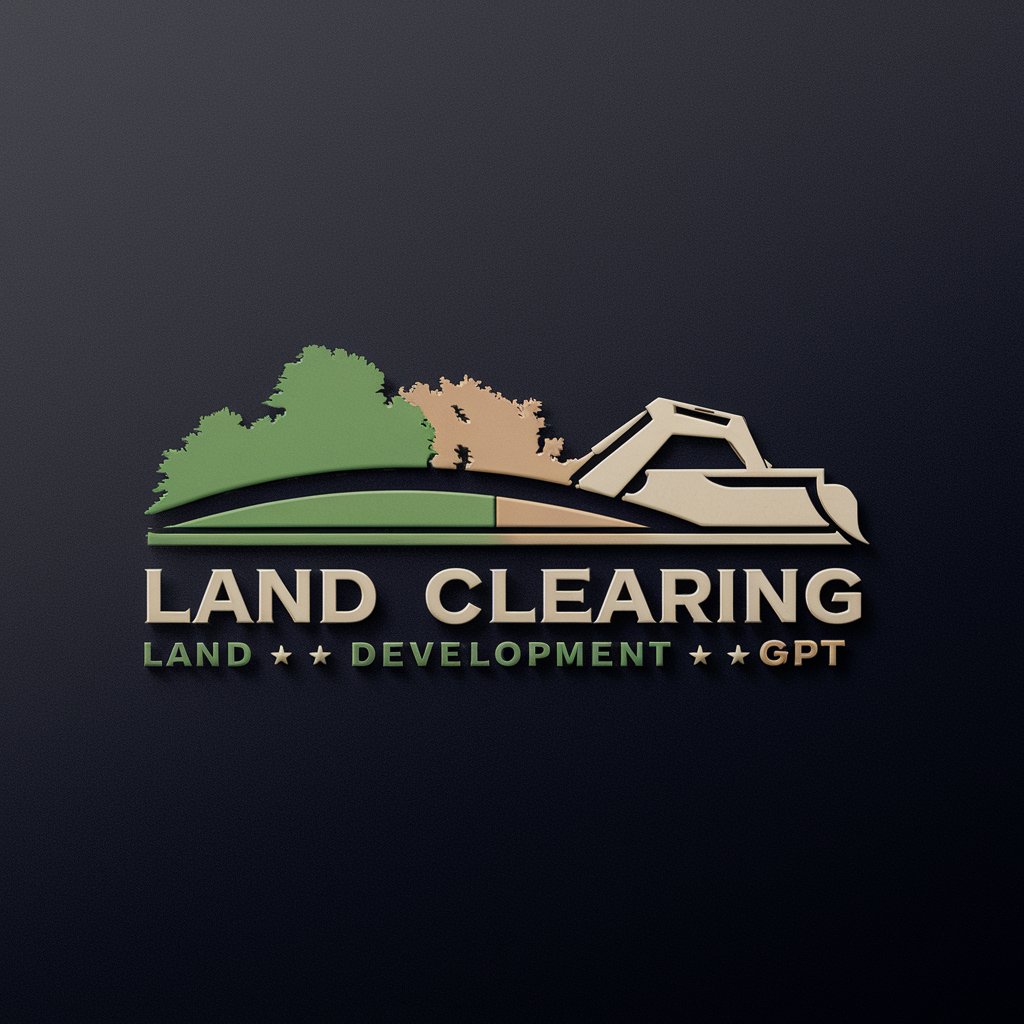
Land Clearing - Land Clearing Insights

Welcome! How can I assist you with your land clearing needs today?
Empowering efficient land development with AI.
What are the most effective methods for land clearing in...
Can you explain the different types of equipment used for...
What environmental considerations should be taken into account when...
How do regulations impact the process of land clearing in...
Get Embed Code
Overview of Land Clearing
Land clearing encompasses a range of activities aimed at removing obstacles such as trees, bushes, stones, and other debris from a parcel of land to prepare it for development or agricultural use. This process is critical for various projects, including residential and commercial construction, road building, and farming expansion. Land clearing is designed to transform the land into a usable state, addressing challenges like uneven terrain, dense vegetation, and existing structures. For example, before constructing a new housing development, the land must be cleared of trees and underbrush to create a safe, accessible construction site. Similarly, in agriculture, clearing land might involve removing old tree stumps and rocks to expand arable land for crops. Powered by ChatGPT-4o。

Key Functions of Land Clearing
Vegetation Removal
Example
Clearing trees, shrubs, and underbrush to prepare land for construction.
Scenario
Before the development of a new residential area, specialized machinery like bulldozers and chainsaws are used to remove vegetation, ensuring a clear and level area for building homes.
Site Preparation and Grading
Example
Leveling and grading the land for infrastructure projects.
Scenario
In the construction of a new highway, land clearing services are essential for grading the path of the road, removing hills, and filling in valleys to create a stable foundation for paving.
Debris Removal and Disposal
Example
Eliminating leftover debris and waste from cleared land.
Scenario
After a major storm, a land clearing service might be called to remove fallen trees, branches, and other debris to restore the usability of agricultural fields or residential areas.
Stump Grinding and Removal
Example
Removing remaining tree stumps to prevent hazards and promote land usability.
Scenario
Following the clearing of a future park area, stump grinding machines are utilized to eliminate stumps, preventing them from becoming tripping hazards and clearing the way for landscaping and development.
Target Users of Land Clearing Services
Construction Companies
Firms engaged in residential, commercial, or infrastructure construction that require land to be cleared and prepared before starting their projects. These users benefit from land clearing services by ensuring their sites are ready for development, adhering to safety standards, and optimizing construction timelines.
Agricultural Operators
Farm owners and agricultural businesses looking to expand their arable land or repurpose land for different types of crops. These users benefit by increasing their productive land area, improving accessibility, and enhancing land management practices.
Real Estate Developers
Individuals and companies that purchase land with the intent of developing it for residential, commercial, or industrial use. They rely on land clearing to transform undeveloped land into profitable projects, addressing environmental and regulatory considerations in the process.
Government and Municipalities
Public sector entities responsible for the development of public infrastructure, parks, and community projects. They benefit from land clearing services by facilitating the creation of roads, utilities, and public spaces that serve the community.

How to Utilize Land Clearing
1
Start with a free trial at yeschat.ai, no login or ChatGPT Plus subscription required.
2
Identify the specific land clearing needs for your project, such as the type of vegetation to be cleared, the size of the area, and any environmental considerations.
3
Select the appropriate land clearing method and equipment based on your project's requirements. Common methods include manual clearing, mechanical clearing, and chemical clearing.
4
Ensure compliance with local regulations and obtain necessary permits. This may involve conducting environmental impact assessments and following guidelines for protected species.
5
Implement best practices for land clearing to minimize environmental impact, such as erosion control measures, selective clearing, and repurposing cleared vegetation as mulch or biofuel.
Try other advanced and practical GPTs
Entrepreneurial Product Manager
Empowering Product Success with AI

Content Maestro
Empower Your Words with AI

Dream Consultant
Unlock insights from your dreams with AI.

DISC Dynamics Guru
Empowering Insights with AI-Driven DISC Analysis

Career Path
Empower Your Career Journey with AI

Career Elevator
Elevate Your Career with AI

Sandeep Anand - Career & Business Coach
Empowering Your Professional Journey with AI

Social Media Department Assistant
AI-powered Social Media Management

Theater Department Assistant
Elevating Theater Productions with AI

Maternity Department Assistant
Streamlining Maternity Documentation with AI

Fertility Department Assistant
Streamlining Fertility Documentation with AI

Production Department Assistant
Streamline production with AI assistance

Frequently Asked Questions about Land Clearing
What is the most efficient method for land clearing?
The most efficient method depends on the project's specific requirements, including the size of the area, type of vegetation, and environmental considerations. Mechanical clearing with heavy machinery like bulldozers and excavators is fast for large areas, while manual clearing might be better for smaller, sensitive areas.
How do I minimize environmental impact during land clearing?
To minimize environmental impact, consider using selective clearing methods, repurposing cleared vegetation, implementing erosion control measures, and adhering to local wildlife protection guidelines.
What are the legal requirements for land clearing?
Legal requirements vary by location but generally include obtaining necessary permits, conducting environmental impact assessments, and following guidelines for protected species and habitats.
Can land clearing affect soil health?
Yes, land clearing can significantly affect soil health by increasing erosion, reducing organic matter, and altering the soil's microbial community. Employing sustainable practices like mulching can help mitigate these impacts.
What is the role of technology in modern land clearing?
Technology plays a crucial role in modern land clearing, from GPS and GIS for planning and executing clearing operations to advanced machinery for efficient clearing, and software for regulatory compliance and environmental impact assessment.





